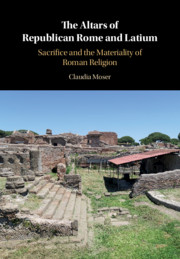Refine search
Actions for selected content:
5872 results in Classical art and architecture

The Altars of Republican Rome and Latium
- Sacrifice and the Materiality of Roman Religion
-
- Published online:
- 04 January 2019
- Print publication:
- 17 January 2019
Practical Information
-
- Book:
- Gender, Identity and the Body in Greek and Roman Sculpture
- Published online:
- 21 September 2018
- Print publication:
- 11 October 2018, pp xv-xvi
-
- Chapter
- Export citation
Glossary of Greek and Latin Terms
-
- Book:
- Gender, Identity and the Body in Greek and Roman Sculpture
- Published online:
- 21 September 2018
- Print publication:
- 11 October 2018, pp 181-186
-
- Chapter
- Export citation
1 - The Male Body: Doryphoros
-
- Book:
- Gender, Identity and the Body in Greek and Roman Sculpture
- Published online:
- 21 September 2018
- Print publication:
- 11 October 2018, pp 21-34
-
- Chapter
- Export citation
Bibliography
-
- Book:
- The Poetics of Power in Augustan Rome
- Published online:
- 18 September 2018
- Print publication:
- 11 October 2018, pp 255-290
-
- Chapter
- Export citation
5 - The Indefinite Body: Sleeping Hermaphrodite
-
- Book:
- Gender, Identity and the Body in Greek and Roman Sculpture
- Published online:
- 21 September 2018
- Print publication:
- 11 October 2018, pp 76-88
-
- Chapter
- Export citation
6 - The Political Body: Prima Porta Augustus
-
- Book:
- Gender, Identity and the Body in Greek and Roman Sculpture
- Published online:
- 21 September 2018
- Print publication:
- 11 October 2018, pp 89-109
-
- Chapter
- Export citation
Illustrations
-
- Book:
- The Poetics of Power in Augustan Rome
- Published online:
- 18 September 2018
- Print publication:
- 11 October 2018, pp viii-x
-
- Chapter
- Export citation
Contents
-
- Book:
- Gender, Identity and the Body in Greek and Roman Sculpture
- Published online:
- 21 September 2018
- Print publication:
- 11 October 2018, pp v-v
-
- Chapter
- Export citation
Chapter 3 - Questioning Consensus on the Palatine
-
- Book:
- The Poetics of Power in Augustan Rome
- Published online:
- 18 September 2018
- Print publication:
- 11 October 2018, pp 83-141
-
- Chapter
- Export citation
4 - The Ageing Body: Drunken Old Woman
-
- Book:
- Gender, Identity and the Body in Greek and Roman Sculpture
- Published online:
- 21 September 2018
- Print publication:
- 11 October 2018, pp 62-75
-
- Chapter
-
- You have access
- HTML
- Export citation
Acknowledgements
-
- Book:
- Gender, Identity and the Body in Greek and Roman Sculpture
- Published online:
- 21 September 2018
- Print publication:
- 11 October 2018, pp xvii-xviii
-
- Chapter
- Export citation
9 - The Other Body: Marble Relief with Female Gladiators
-
- Book:
- Gender, Identity and the Body in Greek and Roman Sculpture
- Published online:
- 21 September 2018
- Print publication:
- 11 October 2018, pp 138-152
-
- Chapter
- Export citation
Copyright page
-
- Book:
- Gender, Identity and the Body in Greek and Roman Sculpture
- Published online:
- 21 September 2018
- Print publication:
- 11 October 2018, pp iv-iv
-
- Chapter
- Export citation
3 - The Veiled Body: Tanagra Statuette
-
- Book:
- Gender, Identity and the Body in Greek and Roman Sculpture
- Published online:
- 21 September 2018
- Print publication:
- 11 October 2018, pp 49-61
-
- Chapter
- Export citation
Contents
-
- Book:
- The Poetics of Power in Augustan Rome
- Published online:
- 18 September 2018
- Print publication:
- 11 October 2018, pp vii-vii
-
- Chapter
- Export citation
Copyright page
-
- Book:
- The Poetics of Power in Augustan Rome
- Published online:
- 18 September 2018
- Print publication:
- 11 October 2018, pp iv-iv
-
- Chapter
- Export citation
10 - The Non-Human Body: Pan and a She-Goat
-
- Book:
- Gender, Identity and the Body in Greek and Roman Sculpture
- Published online:
- 21 September 2018
- Print publication:
- 11 October 2018, pp 153-163
-
- Chapter
- Export citation
Epilogue: Bernini’s ‘Neptune and Triton’
-
- Book:
- Gender, Identity and the Body in Greek and Roman Sculpture
- Published online:
- 21 September 2018
- Print publication:
- 11 October 2018, pp 164-180
-
- Chapter
- Export citation
Chapter 6 - The Last Word?
-
- Book:
- The Poetics of Power in Augustan Rome
- Published online:
- 18 September 2018
- Print publication:
- 11 October 2018, pp 240-254
-
- Chapter
- Export citation
